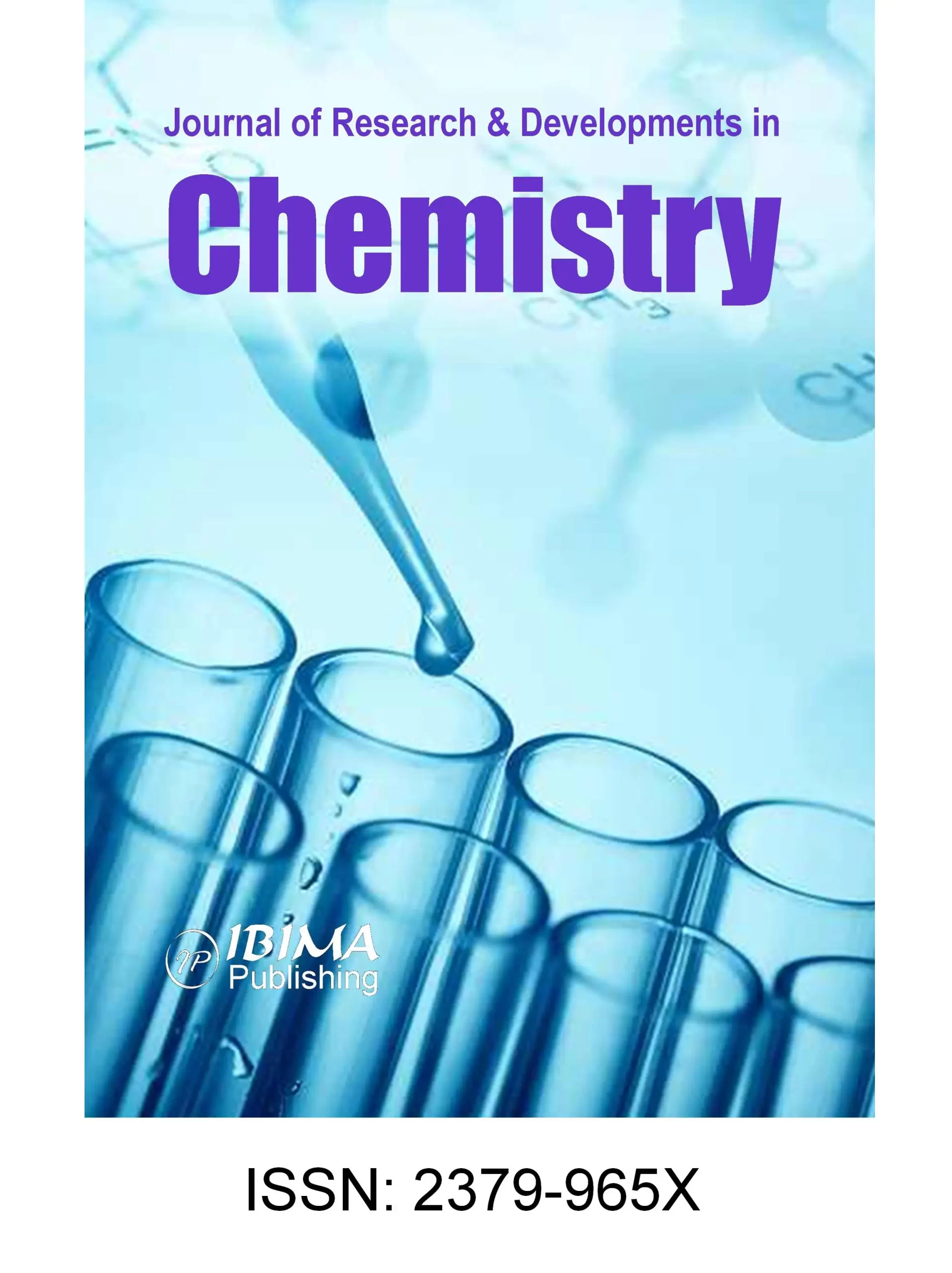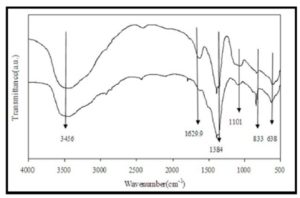Introduction
The innovation of catalytic materials as powerful tools for the transformation of chemical raw materials in the forest is greatly significant in the production and application of forestry chemicals. As the main component of turpentine oil, α-pinene not only is a kind of renewable starting material for producing a wide variety of valuable products, but also a readily available and inexpensive of natural resources. Specifically, its oxidation products (see Scheme 1) such as verbenol, verbenone and α-pinene epoxide are of high practical importance as flavor chemicals and key intermediates for the manufacture of various fine chemicals, as Maksimchuk et al (2005) mentioned, including medicine intermediates, spice additives, fragrances, and agrochemicals, citral, menthol, taxol etc.
Scheme1: The reaction of α-pinene oxidation
Much effort in the α-pinene oxidation reaction has been mainly devoted to the survey of the new recyclable catalytic system with the environmentally friendly oxidants. Hydrogen peroxide is as the oxidant, which has a large number of advantages including (a) it simplifies greatly the work-up to avoid the separation of the carboxylic acid as by-product, (b) it produces a lower amount of water as the only by-product and is environmentally friendly, (c) it is commercially available, inexpensive, and easy to handle, (d) it contains a higher concentration of active oxygen (30 wt%) than all other oxidants except molecular oxygen, therefore it can improve process economics. On the other hand, hydrogen peroxide is kinetically more inert with respect to organic peracids and its direct use, as the oxidant requires a suitable catalyst for sufficient activity and excellent selectivity.
The main three products of α-pinene oxidation are α-pinene epoxide, verbenol and verbenone. In addition, the existence of other byproducts such as camphene and sobrerol etc, which cannot be avoided due to the active allyl-bit and its special double bonds, therefore, the catalyst plays a key role between the two competing reactions. Different catalysts lead to different conversions and generating the main three kinds of product ratio being different, the property of a catalyst decides the consequence. In a research study by Tzialla (2010), the use of a number of different catalysts has dramatically revolutionized oxidation processes with hydrogen peroxide. In recent years, Qi (2010) and Patil (2001) have focused on the development of heterogeneous catalysts that accord with green chemistry. Manganese and cobalt (II)-containing zeolite have emerged as the major breakthrough in the alkenes epoxidation using H2O2 as oxidant. Chakrabarty (2004) mentioned tetrameric cobalt (III) complexes, Timofeeva (2012) mentioned vanadium-based catalysts on mesoporous supports, and Nagendrappa’s (2011) clay-based catalysts have been successfully used for the α-pinene oxidation. Layered double hydroxides (LDHs), known as hydrotalcite-like compounds (HTLc), have been widely applied in various organic reactions, such as in the research study by Kristina (2014) and Tatsumi (1993), with advantages such as effective activity, high selectivity, excellent metal dispersion, less waste production, and an improved recuperation of immobilized catalysts. Various catalysts based on LDHs structures are used in alkene oxidation reactions. Aramendia (2000) discussed the catalytic properties of different LDHs in the epoxidation of limonene to limonene oxide, and Kaneda (1995) uses molecular oxygen and aldehydes as a combination oxidant of several ketones. Through high activity, selectivity, and chiral induction, this system also has several disadvantages, including the fact that the flow rate of oxygen cannot be easily controlled and it is difficult to realize industrialization.
Mandal (2012) mentioned that, alginates are important, naturally occurring biopolymers and the block copolymers of uronic acids, a structural component of an algal cell wall, has been widely used for biomolecule immobilization and is a potent metal chelator. Sodium alginate can be exchanged by metal cations and then be coordinated with the —OH of the carboxylate groups to generate the ion-cross-linked alginates. They have been used in several applications. In the research study by Shi (2012) and Monakhova (2012), organic-inorganic composite materials containing various salts of alginic acid were found to be useful for application in catalysis.
Therefore, in the present work, we synthesized sodium alginate intercalated the three types of flaky layered double hydroxides (FLDH/SA) under the microwave irradiation. At the same time, the as-synthesized samples were applied in the catalytic α-pinene oxidation with the H2O2 as oxidant. Factors affecting the reaction with Zn-CFLDH/SA as the catalyst, such as reaction medium, and reaction time were also investigated in details.
Experimental
Materials
All chemicals were analytical grade without further purification. Zinc nitrate, copper nitrate, magnesium nitrate, aluminium nitrate, sodium hydroxide and sodium alginate (SA) were purchased from Tian Jin Kemiou Fine Chemical Reagent. Acetone, ethanol, CH2Cl2, CHCl3, methanol and n-decane were offered from Tianjin Heowns Biochemical Technology Chemical Industry. Standard samples including α-pinene, α-pinene epoxide, verbenol and verbenone were offered from Aladdin Reagent.
Preparation of Catalysts
An 80 ml aqueous solution containing 60 ml bivalent metal nitrates (Mg(NO3)2ã€Cu(NO3)2 or Zn(NO3)2 and 20 ml trivalent metal nitrates (Al(NO3)3), with another 140 ml solution, which containing 1 mol-L-1 NaOH and 0.01 mol-L-1 SA solution were simultaneously titrated into a three necked round-bottom flask under vigorous stirring at 70 oC. The titration rates of the solutions were controlled in order to maintain the pH value of the mixture solution at about 8-9. After the titration and one hour’s vigorous stirring, a heavy precursor gel was obtained, and then crystallized at 70 oC for 15 minutes under microwave irradiation (Midea KD23B-DA, at max power 1300 W and a frequency of 2.45 GHz). The precipitate was filtered, washed to pH 7 and dried to obtain the three types FLDHs/SA. The purposed sample was calcined under 673 K for 4 h to obtain the CFLDH/SA. Zn-FLDH has the same synthetic procedure as above, just without the intercalation agent SA.
Characterization of Catalysts
X-ray powder diffraction (XRD) data were characterized on a Japan Rigaku D/MAX 2200VPC. Data were collected at the rate of 4°/min and in the range of 5-80º. The Fourier transform infrared (FT-IR) spectra were collected using a Nicolet FT-IR 360 spectrometer (KBr pellet method, 4 cm−1 resolution) in the range of 400-4000 cm-1. The morphology of sample was observed by FEI-Quanta 200 scanning electron microscope (SEM) with a field emission of 30 Kv.
Pinene Oxidation
Oxidation of α-pinene over the prepared catalyst with 30wt% hydrogen peroxide was carried out in a 15 ml sealed reaction tube (with stir). In a typical experiment, reaction mixture containing known amounts of α-pinene, catalyst and specific solvent (2 ml). The reaction products were analyzed by gas chromatography (Agilent, Model 6820) equipped with HP-5 capillary column 30 m long and 0.25 mm internal diameter and a flame ionization detector (FID). Nitrogen was used as a carrier gas with injection port temperature of 593 K and programmed ramping of column temperature from 333 K to 533 K. The n-decane was used as an internal standard for calculation.
Results and discussion
Characterization of Catalysts
Fig.1 illustrates the powder X-ray diffraction (XRD) patterns of Zn-FLDH/SA and Zn-CFLDH/SA. A gives several typical reflections at 2θ=10.2, 20.0, 34.4, 61.1, which Rives (2003) mentioned in his paper and confirmed that no significant structural variations occurred after SA intercalated as compared to the original typical reflections, and also shows that it is highly crystalline material. B gives some typical reflections at 2θ=32.1, 36.2, 47.1, 57.3, 63.2, 66.5, which are almost identical to the typical pattern characteristic of ZnO as Shi (2013) reported , while the package peaks between 34.22 ~ 37.5 due to the amorphous peak of Al2O3 as Constantino (1994) mentioned. It can be concluded that the Zn-CFLDH/SA is mostly in the form of metal oxide.
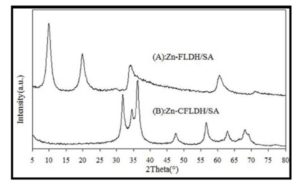 Figure1: X-ray diffraction patterns of Zn-FLDH/SA (A) and Zn-CFLDH/SA (B)
Figure1: X-ray diffraction patterns of Zn-FLDH/SA (A) and Zn-CFLDH/SA (B)
In Fig.2, it can be observed that both samples show strong bands at 3456 cm−1 and 1384 cm−1, as well as a group of other small bands below 1200 cm-1 in the FT-IR spectrum (Fig.2), which Chen (2005) mentioned, and confirmed that the two samples exhibit the structure of hydrotalcite-like compounds. The band centered at around 3456 cm-1 is due to the ν-OH stretching mode of hydrogen-bonded hydroxyl groups and water molecules. The shaper band at 1630 cm−1(Fig2.B)is attributed to C=O stretching vibrations of Zn-FLDH/SA besides M—OH vibration in the brucite-like layers of the two kinds of Zn-FLDH, indicating the presence of the [C5H7O4COO]- ion within the layered double hydroxide. All the characteristic peaks prove that the SA was intercalated into Zn-FLDH successfully.
Figure2: FT-IR spectra of Zn-FLDH/SA (A) and Zn-CFLDH/SA (B)
Fig.3 A and B illustrates the SEM images of Zn-FLDH/SA and Zn-CFLDH/SA, respectively. The A image shows that the sheet particles of Zn-FLDH/SA form petal-like structures with many cavities, and this leads to the hierarchical structure stacking of LDHs nanoflakes according Zhi’s report (2010) . This compound consists of interleaved flexible curled nanosheets that are 10—20 nm thick and 200—500 nm long. This is possibly because in the intercalation reaction of SA, its large ion results in the expansion of LDHs, and the interlayer spacing increases gradually along with the insertion of SA. When the interlayer spacing becomes large enough such that the interaction force between the layers completely disappears, the LDHs appears as monolayer, which then self-assembles into the Zn-FLDH diaphragm in the saturated solution of SA and forms Zn-FLDH/SA nanoflakes. Zn-CFLDH/SA is maintaining the original morphology, apparently, which has flake-like crystals stacked over one another to form layers. But during the calcinations, the water in the laminate and the anion SA- intercalation peeled out from the Zn-CFLDH/SA structure, these lead to more cavities.
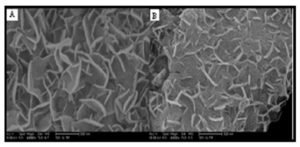
Figure 3: SEM images of Zn- FLDH/SA (A) and Zn-CFLDH/SA (B)
Pinene oxidation
LDHs are efficient catalysts for alkene oxidation carried out, which have been reported by Ray (2011) and Mitran (2012) in previous literature. However, there are still few reports about α-pinene oxidation using hydrogen peroxide as oxidant catalyzed by LDHs. In the present work, the catalytic performances of prepared catalysts were investigated in the α-pinene oxidation; the results are summarized in Table 1. From Table 1, it can be easily found that, compared with FLDH/SA, the CFLDH/SA have higher activity. When we just observe the activity of Zn-containing FLDH, the activity order is Zn-CFLDH/SA >Zn-FLDH/SA > Zn-CFLDH > Zn-FLDH, the difference of conversion rate is evident. Therefore, it can be concluded that the SA in Zn-FLDH/SA plays a key role, as Bhattacharjee (2004) mentioned the gallery height may be increased sufficiently to allow the oxidation of larger dimension organic compounds, and Zn-CFLDH/SA has the same number of active centers and more cavities. Moreover, it can be observed that the main product is verbenol, verbenone and α-pinene epoxide. Additionally, from the above-obtained results in Table 1, it can be observed that the Zn-CFLDHs/SA exhibits the higher conversion of α-pinene and selectivity of verbenol, indicating that Zn-CFLDHs/SA is the best catalyst among all the synthesized catalysts in α-pinene oxidation reaction. Therefore, the present work further investigates the catalytic performances of Zn-CFLDHs/SA in α-pinene oxidation with various reaction parameters in details.
Table 1: Catalytic properties of prepared catalyst in α-pinene oxidation
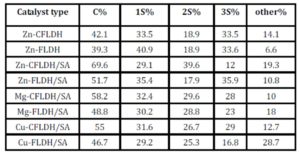
Reaction conditions: 1mmol α-pinene, 1mmol H2O2, 10 mg catalysts, 1 ml acetone and 1 ml distilled water, temperature 60 oC, time 180 min.
C%––conversion of α-pinene, 1S%––selectivity of α-pinene epoxide
2S%––selectivity of verbenol, 3S%––selectivity of verbenone
- Effect of Reaction Medium
In order to investigate the effect of the reaction medium on the α-pinene oxidation catalyzed by Zn-CFLDH/SA, the reaction was performed in various solvents such as water, acetone, mixtures thereof, CH2Cl2, methanol and CHCl3. The results are summarized in Table 2. From Table 2, it can be clearly seen that the Zn-CFLDH/SA-catalyzed α-pinene oxidation gives the highest α-pinene conversion in acetone: water=1:1 as solvent, however, and has lower catalytic activity in anhydrous solvents. This is perhaps due to the following reasons: (1) α-pinene is the insoluble organic matter in water, so the reaction of hydrogen peroxide and α-pinene is two phases of liquid-liquid reaction; (2) adding the solid catalyst, the whole reaction system is three phases of liquid-liquid-solid reaction, acetone/water as the solvent, α-pinene of organic material is easy to contact with acetone, Calcined Zn-CFLDH/SA catalyst is hydrophilic, the solvent can make α-pinene with hydrogen peroxide for miscibility of liquid-liquid-solid system to the liquid-solid two phases, which can be beneficial for reaction. Hence, acetone/water is indicated to be the best alternative solvent for the α-pinene oxidation. The result is in agreement with the previous measurements of Mandelli (2011),the catalytic process, maybe, is a dehydration reaction a small amount of water is advantageous for the reaction. It can not only inhibit the decomposition of H2O2 in the catalyst surface, but also inhibits the catalytic epoxidation products of ring-opening reactions and rearrangement reactions. Moreover, peroxide activates hydroxyl groups on the surface of the crystal and reacts with α-pinene; the catalyst can keep high activity either in acidic, neutral or alkaline.
Table 2: Effect of reaction medium on α-pinene oxidation catalyzed by Zn-CFLDH/SA
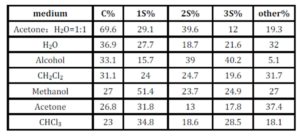
Reaction conditions: 1mmol α-pinene, 1mmol H2O2, 10 mg catalysts (Zn-CFLDH/SA), 2 ml solvent, temperature 60 oC, time 180 min.
The effect of reaction time on the α-pinene oxidation reaction catalyzed by Zn-CFLDH/SA was investigated. The results are shown in Fig.4, which reveals that the α-pinene conversion increases drastically with an increasing reaction time at the beginning and then levels off at 70% after 3 hours, because of the reaction fulfillment. However, the selectivities of the three products show major change and this maybe depends on the specific formed cation evolving after protonation of the a-pinene molecule at the beginning of the reaction.
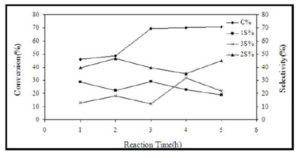
Figure 4: Effect of reaction time
Reaction conditions: 1mmol α-pinene, 1mmol H2O2, 10 mg catalysts(Zn-CFLDH/SA), 1 ml acetone and 1 ml distilled water, temperature 60 oC.
Conclusions
FLDH/SA as catalyst precursors were prepared under microwave irradiation, which was calcined to catalyze the oxidation of α-pinene with hydrogen peroxide as oxidant. The purposed sample was characterized by XRD, IR and SEM. The results show that the synthesized FLDH/SA with the flexible slice have the structure of LDH, indicating the preparation is successful under microwave irradiation. The calcined product is uniform state. The catalytic activity order of the prepared catalyst for α-pinene oxidation is Zn-CFLDH/SA >Zn-FLDH/SA > Zn-CFLDH >Zn-FLDH, which imply SA plays an important role in the reaction and Zn-CFLDH/SA is the best catalyst for α-pinene oxidation with 30wt% hydrogen peroxide as oxidant. The conversion rate of α-pinene can reach 69.6% under the reaction conditions of acetone: water = 1:1 as reaction solvent, Zn-CFLDH/SA catalyst concentration of 0.431 g/L and reaction time of 3 h.
Acknowledgment
The investigation was supported by the Fundamental Research Funds for the Central Universities (No. 2572014DB04) and the Specialized Research Fund for the Doctoral Program of Higher Education(No.20120062120012).
References
1. Aramendía, M. A, Borau, V. and Jiménez, C. (2000) “Epoxidation of limonene with layered-double hydroxides as catalysts.” Stud Surf Sci Catal, 130:1667-1672.
2. Bhattacharjee, S. and Anderson, J. A. (2004) “Synthesis and characterization of novel chiral sulfonato— salen—manganese (III) complex in a zinc—aluminium LDH host .” Chem Commun, 5(1-2): 554-555.
Publisher – Google Scholar
3. Chakrabarty, R. and Das, B. K. (2004) “Epoxidation of α-pinene catalysed by tetrameric cobalt (III) complexes.” J Mol Catal A: Chem, 223(1-2):39-44.
Publisher – Google Scholar
4. Chen, C. X, Xu, C. H. and Feng, L. R . (2005) “Effect of Rare Earth Doping on the Catalytic Activity of Copper-Containing Hydrotalcites in Phenol Hydroxylation.” Adv Synth Catal, 347(14): 1848-1854.
Publisher – Google Scholar
5. Constantino, V. R. L. and Pinnavaia, T. J. (1994) “Structure-reactivity relationships for basic catalysts derived from a Mg2+-Al3+-CO32-layered double hydroxide.” Catal let, 23(3-4): 361-367.
Publisher – Google Scholar
6. Kaneda, K, Ueno, S. and Imanaka, T. (1995) “Catalysis of transition metal-functionalized hydrotalcites for the Baeyer-Villiger oxidation of ketones in the presence of molecular oxygen and benzaldehyde.” J Mol Catal A: Chem, 102:135-138.
Publisher – Google Scholar
7. Kristina, K. R, Albinas, Ž. and Ričardas, T. (2014) “Preparation of Mg/Al layered double hydroxide (LDH) with structurally embedded molybdate ions and application as a catalyst for the synthesis of 2-adamantylidene(phenyl)amine Schiff base.” Polyhedron, 68:340-345.
8. Maksimchuk, N. V, Melgunov, M. S. and Białoń J. M. (2005) “H2O2-based allylic oxidation of α-pinene over different single site catalysts.” J Catal, 2351(1): 175-183.
Publisher – Google Scholar
9. Mandal, S. and Patil, V. S. (2012) “Alginate and hydrotalcite-like anionic clay compositesystems: Synthesis, characterization and application studies.” Mayadevi S. Microporous Mesoporous Mater,158:241-246.
Publisher – Google Scholar
10. Mandelli, D. and VanVliet, M. C. A. (2001) “Alumina-catalyzed alkene epoxidation with hydrogen peroxide.” Appl Catal A, 219(1-2):209-213.
Publisher – Google Scholar
11. Mitran, G, Cacciaguerra, T. and Loridant, S. (2012) “Oxidative dehydrogenation of propane over cobalt-containing mixed oxides obtained from LDH precursors.” Appl Catal A, 417:153-162.
Publisher – Google Scholar
12. Monakhova, Y, Agulhon, P. and Quignard, F. (2012) “New mixed lanthanum- and alkaline-earth cation-containing basic catalysts obtained by an alginate route.” Catal Today, 189(1): 28-34.
Publisher – Google Scholar
13. Nagendrappa, G. (2011) “Organic synthesis using clay and clay-supported catalysts.” Appl Clay Sci, 53(2):106-138.
Publisher – Google Scholar
14. Patil, M. V, Yadav, M. K. and Jasra, R. V. (2007) “Catalytic epoxidation of α-pinene with molecular oxygen using cobalt(II)-exchanged zeolite Y-based heterogeneous catalysts.” J Mol Catal A: Chem, 277(1-2):72-80.
Publisher – Google Scholar
15. Qi, B, Lu, X. H. and Zhou, D. (2010) “Catalytic epoxidation of alkenes with 30% H2O2 over Mn2+-exchanged zeolites.” J Mol Catal A: Chem, 322(1-2):73-79.
Publisher – Google Scholar
16. Ray, A, Rosair, G. M. and Pilet, G. (2011) “Preferential azido bridging regulating the structural aspects in cobalt(III) and copper(II)—Schiff base complexes: Syntheses, magnetostructural correlations and catalytic studies.” Inorg Chim Acta, 375(1): 20-30.
Publisher – Google Scholar
17. Rives, V, Prieto, O. and Dubey, A. (2003) “Synergistic effect in the hydroxylation of phenol over CoNiAl ternary hydrotalcites.” J Catal, 220(1): 161-171.
Publisher – Google Scholar
18. Shi, F. W, Chen ,Y. G. and Sun, L. P. (2012) “Hydroxylation of phenol catalyzed by different forms of Cu”alginate with hydrogen peroxide as an oxidant[J].” Catal.Commun., 25:102-105.
Publisher – Google Scholar
19. Shi, R. X, Yang, P. and Dong, X. B. (2013) “Growth of flower-like ZnO on ZnO nanorod arrays created on zinc substrate through low-temperature hydrothermal synthesis.” Appl Surf Sci, 264:162-170.
Publisher – Google Scholar
20. Tatsumi, T, Tajima, H. and Yamamoto, K. (1993) “Epoxidation of Alkenes Catalyzed by Decatungstate as Pillars in Layered Double Hidroxides.” Stud Surf Sci Catal, 75: 1703-1706.
21. Timofeeva, M. N, Hasan, Z. and Panchenko, V. N. (2012) “Vanadium-containing nickel phosphate molecular sieves as catalysts for α-pinene oxidation with molecular oxygen: A study of the effect of vanadium content on activity and selectivity.” J Mol Catal A: Chem, 363:328-334.
Publisher – Google Scholar
22. Tzialla, A. A, Pavlidis, I. V. and Felicissimo, M. P. (2010) “Lipase immobilization on smectite nanoclays: Characterization and application to the epoxidation of α-pinene.” Bioresour Technol, 101(6):1587-1594.
Publisher – Google Scholar
23. Zhi, Y, Li, Y. G. and Zhang, Q. H. (2010) “ZnO Nanoparticles Immobilized on Flaky Layered Double Hydroxides as Photocatalysts with Enhanced Adsorptivity for Removal of Acid Red G.”Langmuir, 26(19): 15546-15553.
Publisher – Google Scholar



